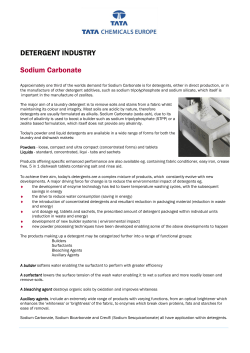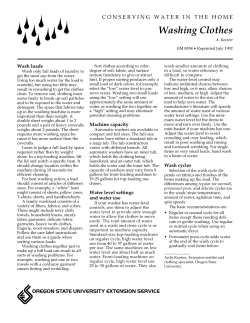
From DPD to CLP – The Detergent Industry Network for CLP Classification
From DPD to CLP – The Detergent Industry Network for CLP Classification Anna Melvås The Swedish Cosmetic, Toiletry and Detergent Association Member companies: ca 130 Statistics Network Legislation Staff: Olof Holmer, VD, Anna Melvås, Peter Jansson, Ulrika Flodberg*, Lorena Costa Individual service Education Media * Ulrika Flodberg, IIH, The Swedish Association of Industrial and Institutional Hygiene Products From DPD to CLP DPD Calculation (conventional method) or CLP Test data on the mixture Data on the mixture itself*? classify Data on similar tested mixtures (bridging principle)? classify Calculation based on ingredient classification classify Other data may be taken into account classify DPD and CLP Eye effects Mixture containing R41, Eye Cat 1, substance: CLP classification • You have a mixture to classify: TEST THE MIXTURE IN VITRO (or use existing data on this mixture) Expensive Takes some time Interpretation not always easy Suitable in vitro method selection BRIDGING PRINCIPLES (if you have data on similar tested mixtures) CALCULATION Easiest Legal certainty Conservative More severe classification and labelling likely Welcome to the DetNet • The Detergent Industry Network for CLP Classification • Appropriate classification and labelling that reflects actual effects on man • Manufacturers of detergents can have access to shared test data and expert judgement • Open to all companies manufacturing/supplying detergents Or “not classified” (only in specific cases) Drain cleaner www.det-net.eu Hand dishwash detergent Scope of the DetNet Products: Laundry detergents (liquids, powders) Hand dishwash detergents All-purpose cleaners liquids (non-extreme pH products) Other cleaning and maintenance product types with similar chemistry (i.e. surfactants-based e.g. car wash products) Consumer and professional products Endpoints: skin and eye effects www.det-net.eu DetNet features Web-based IT system Data sharing for all users, expertise • IT-system searches the database of Reference Formulations • Security (individual access code), confidentiality protected • Approx. 200 formulations • Enhanced composition details on reference formulations • Recent in vitro data using enhanced test method for eye effects, study summary • Scientific Advisory Panel comprising experts from academia Standardized process and records • Classification Record using a standard format • Classification logging number as proof • Classification explanatory notes Training and support • Training of classification experts • Help Desk support • FAQ www.det-net.eu How to access the DetNet www.det-net.eu DetNet organization Network Management DATABASE - ca 200 formulations - toxicity data: historical in vivo new in vitro - Process - Database Secured Web / IT tool SCIENTIFIC ADVISORY PANEL “Guidance & Quality Assurance” - Medical/Toxicological experts from e.g. Academia, Poison Centers, Industry www.det-net.eu AUTHORITIES Access info on request EXPERT POOL - Internal and External experts - Nominated/Trained Evaluation/ Classification COMPANY placing product on the market: Responsibility for final classification DetNet fees Annual membership fees Covers IT, administration, support Based on self-declared turnover for your detergent products within DetNet’s scope in EU + EFTA countries * + Turkey Classification Logging fees Fixed fee: 90 € / successful classification using DetNet (successful classification = being able to derive a classification using one or more reference formulation(s) and bridging principles(s)) www.det-net.eu Turnover band (Euro million) Fee (€ per annum) AISE direct member companies 100. to 1000 1500 1000 to 2500 2500 >2500 3500 NA member companies <1 250 1 to 5 500 5 to 25 750 25 to 100 1000 >100 1500 Non-member companies <1 1 to 5 5 to 25 25 to 100 >100 1250 2500 3750 5000 7500 Illustrative potential cost Company X is a NA member company. Annual turnover of > 100 million €. Classifies 100 formulations per year using DetNet. DetNet annual membership fee 1500€ 100 Classification Logging fees @ 90€ 9000€ Total potential annual cost Total cost of 10.500 € would only fund costs for: around 6 in vitro skin irritation studies or around 5 in vitro eye (ICE + histopathology) studies. www.det-net.eu 10.500€ 5 reasons to join Access to shared industry data Appropriate skin/eye hazard labels on your products Cost-effective and convenient Expertise and support Consistent industry approach www.det-net.eu Expected with DetNet www.det-net.eu Test formulation input www.det-net.eu Test formulation ingredients www.det-net.eu Filters www.det-net.eu Reference formulations suggested www.det-net.eu Reference formulations details www.det-net.eu Reference formulations details www.det-net.eu Classification record www.det-net.eu Classification record • Final classification record as pdf www.det-net.eu Classification record • Final classification record as pdf www.det-net.eu List of members Bettari Detergenti Srl Buck-Chemie GmbH Colgate-Palmolive Europe Claro products Dalli Werke GmbH &Co. KG Danlind as Delta pronatura Dr. Krauss & Dr. Beckmann KG Dreco Werke Wasch- und Körperpflegemittel GmbH Dr.O.K. Wack Chemie GmbH Fala-Werk Chemische Fabrik Henkel www.det-net.eu Lilleborg AS Madel SPA McBride Plc Nicols France SealedAir Selden Research Steinfels Swiss, Division of Coop Thurn-Produkte Unilever Van Dam Bodegraven BV Walter Becker Werner & Mertz GmbH AISE DetNet For more information: www.det-net.eu Thank you! Anna Melvås, KTF anna.melvas@ktf.se www.det-net.eu
© Copyright 2025
















